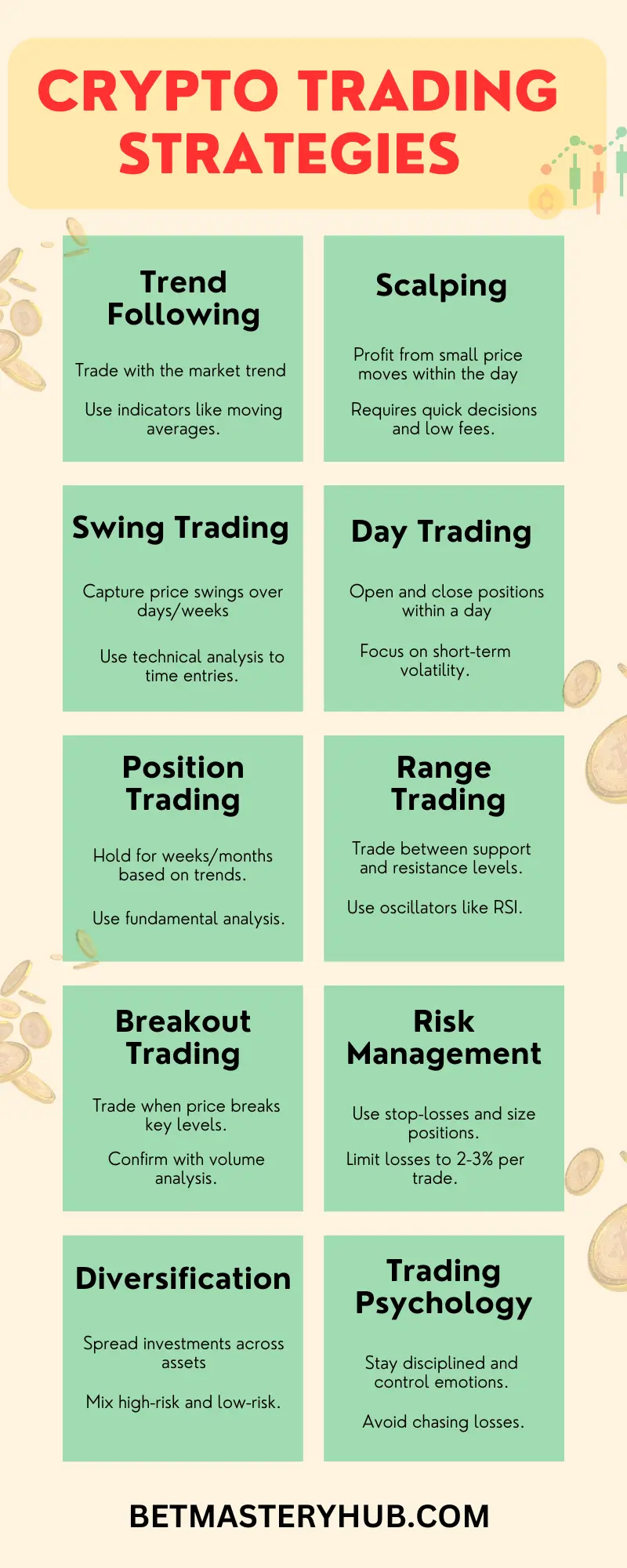Table of Contents
Cryptocurrency trading has revolutionized financial markets, offering individuals new opportunities to invest and earn profits. Unlike traditional investments, crypto trading operates on a decentralized blockchain, ensuring transparency, security, and accessibility for traders worldwide.
Whether you’re a beginner or an experienced investor, understanding the fundamentals of crypto trading, risk management, and market dynamics is crucial for success. This guide will walk you through the essential aspects of crypto trading, including how it works, the benefits, strategies, and the role of regulation in the industry.
What is Cryptocurrency Trading?
Cryptocurrency trading involves buying and selling digital currencies through online exchanges with the goal of making a profit. These digital assets, such as Bitcoin and Ethereum, operate on blockchain networks, ensuring secure and transparent transactions.
Traders engage in crypto trading to capitalize on market volatility, where prices fluctuate rapidly, presenting both opportunities and risks. Unlike traditional stock markets, crypto trading operates 24/7, offering unmatched flexibility.
How Crypto Trading Works:
- Creating an Account:
- Register on a reliable cryptocurrency exchange.
- Complete identity verification to comply with regulatory requirements.
- Deposit funds using fiat currencies or other cryptocurrencies.
- Buying and Selling:
- Use deposited funds to buy cryptocurrencies at a favorable price.
- Sell assets when the market price increases to secure profits.
- Storing Your Assets:
- Store cryptocurrencies in secure wallets (hot or cold wallets).
- Protect your account with two-factor authentication and strong passwords.
- Monitoring Market Trends:
- Track price movements and news updates affecting the market.
- Use trading tools to analyze trends and make informed decisions.
Benefits of Crypto Trading
Crypto trading offers numerous advantages compared to traditional investment options. Here are some key benefits of investing in cryptocurrencies:
- 24/7 Market Access: Unlike stock exchanges, crypto markets operate round-the-clock, allowing traders to enter and exit positions at their convenience.
- High Liquidity: Leading cryptocurrencies like Bitcoin and Ethereum enjoy high liquidity, enabling seamless buying and selling.
- Decentralization: Blockchain technology ensures transparency and security without the need for intermediaries.
- Volatility and Profit Potential: While market volatility presents risks, it also offers opportunities for substantial gains.
- Diversification: Cryptocurrencies provide an additional asset class for portfolio diversification.
Despite these benefits, it’s important to understand the risks involved and adopt appropriate trading strategies to protect your investment.
Risks of Cryptocurrency Trading
However, as with any financial activity, there are risks involved in cryptocurrency trading:
- Market Volatility: The high volatility of cryptocurrencies can lead to significant losses if a trade goes wrong.
- Lack of Regulation: The absence of regulatory oversight in some markets can make crypto trading risky, especially when dealing with untrustworthy exchanges.
- Security Concerns: While blockchain is secure, crypto wallets and exchanges can still be vulnerable to hacking or phishing attacks.
- Emotional Stress: Crypto markets can be highly volatile, leading to emotional stress for traders. It’s essential to trade with caution and avoid making impulsive decisions.
The Role of Blockchain in Cryptocurrency Trading
Blockchain is the underlying technology behind cryptocurrencies. It is a decentralized ledger that records all transactions across a network of computers. Every time a transaction is made, it is verified by multiple nodes on the network, ensuring transparency and security.
- Transparency: Blockchain technology ensures that every transaction is recorded transparently, making it difficult for malicious actors to manipulate the system.
- Decentralization: Unlike traditional financial systems, cryptocurrencies are decentralized, meaning they are not controlled by a single entity like a bank or government.
- Security: Blockchain uses advanced cryptography to secure transactions and protect users’ funds.
Types of Crypto Trading
There are several ways to trade cryptocurrencies, each with its own risks and rewards. The most popular types are:
1. Spot Trading
Spot trading involves buying or selling cryptocurrencies for immediate delivery. This is the most common type of crypto trading, where users exchange one cryptocurrency for another or for fiat money (e.g., USD, EUR).
2. Margin Trading
Margin trading allows users to borrow funds from an exchange to amplify their trading positions. While this can lead to higher profits, it also increases the risk, as you may end up losing more than your initial investment.
3. Futures Trading
Futures contracts are agreements to buy or sell an asset at a future date at a predetermined price. In crypto futures trading, traders speculate on the future price of cryptocurrencies, which can lead to significant profits or losses.
4. Options Trading
Options trading in crypto works similarly to traditional options in the stock market. Traders buy the right, but not the obligation, to buy or sell an asset at a specific price on or before a certain date.
Key Trading Strategies for Success
Effective trading requires strategic planning, analysis, and risk management. Here are some common strategies used by successful crypto traders:
1. Day Trading
- It involves buying and selling cryptocurrencies within the same day.
- Aims to capitalize on short-term price movements.
- Requires constant market monitoring and quick decision-making.
2. Swing Trading
- Focuses on taking advantage of medium-term price swings.
- Traders hold positions for days or weeks based on technical analysis.
- Reduces stress compared to day trading.
3. HODLing (Long-Term Investing)
- It involves buying cryptocurrencies and holding them for an extended period.
- Based on the belief in long-term market growth.
- Ideal for investors who prefer a hands-off approach.
4. Scalping
- A high-frequency trading strategy that aims to make small profits from multiple trades.
- Requires advanced technical skills and market knowledge.
Choosing the right strategy depends on your risk tolerance, time commitment, and market knowledge.

Key Concepts in Crypto Trading
When diving into crypto trading, understanding these key concepts is crucial:
- Volatility: Cryptocurrencies are known for their price volatility. This means that the value of a digital asset can rise or fall rapidly within short periods.
- Liquidity: This refers to how easily an asset can be bought or sold in the market. Highly liquid markets have many buyers and sellers, making it easier to execute trades.
- Regulation: Cryptocurrency regulations vary by country. While some nations have embraced crypto trading, others have imposed strict regulations or outright bans. Traders must be aware of the regulatory environment in their jurisdiction.
- Exchanges: Crypto exchanges are platforms where traders can execute transactions. Popular exchanges include Binance, Coinbase, Kraken, and Bitfinex. Each platform has its own set of rules, fees, and available cryptocurrencies.
- Investment Strategies: Different strategies can be employed to maximize profits, such as day trading, swing trading, and holding for the long term.
The Role of Exchanges in Crypto Trading
Cryptocurrency exchanges serve as the primary platforms for trading digital assets. They facilitate the buying and selling of cryptocurrencies while offering various features, including:
- Spot Trading: Direct purchase or sale of cryptocurrencies at current market prices.
- Margin Trading: Allows traders to borrow funds and trade with leverage for higher returns (and higher risks).
- Derivatives Trading: Includes futures and options contracts for speculative trading.
- Staking and Earning: Some exchanges offer staking programs, allowing users to earn passive income by holding specific cryptocurrencies.
Choosing the Right Exchange
When selecting a crypto exchange, consider the following factors:
- Security Measures: Ensure the exchange has strong security protocols to protect your funds.
- Regulatory Compliance: Verify if the platform adheres to financial regulations and compliance standards.
- Transaction Fees: Compare deposit, withdrawal, and trading fees.
- User Experience: A user-friendly interface simplifies trading for beginners.
- Supported Cryptocurrencies: Ensure the exchange supports a wide range of digital assets.
Popular crypto exchanges include Binance, Coinbase, Kraken, and Bitfinex.
Understanding Market Volatility
Crypto markets are known for their extreme volatility, with prices fluctuating rapidly within short timeframes. While this presents lucrative trading opportunities, it also introduces significant risks.
Factors Contributing to Market Volatility:
- Regulatory Changes: Government policies and regulations can impact market sentiment and prices.
- Market Speculation: Investor sentiment and speculation often drive price movements.
- Technological Developments: Innovations and upgrades in blockchain technology influence prices.
- Market Manipulation: Large investors (whales) can manipulate prices by executing large trades.
To navigate market volatility, traders should implement risk management techniques such as setting stop-loss orders and diversifying their investment portfolios.
Importance of Regulation in Crypto Trading
As cryptocurrency adoption grows, global authorities are introducing stricter regulatory frameworks to ensure market integrity and investor protection. Regulations help mitigate risks such as fraud, money laundering, and market manipulation.
Key Regulatory Aspects to Consider:
- KYC (Know Your Customer): Traders must verify their identities before trading on regulated platforms.
- AML (Anti-Money Laundering): Exchanges follow guidelines to prevent illicit financial activities.
- Tax Compliance: Profits from crypto trading are subject to taxation in many countries.
- Exchange Licensing: Ensure that your chosen exchange operates under proper licensing and compliance standards.
Staying informed about evolving crypto regulations is crucial for maintaining compliance and avoiding potential legal issues.
Setting Up a Crypto Trading Account
Starting your crypto trading journey requires setting up an account on a reputable exchange. Here’s a step-by-step guide to help you get started:
- Choose an Exchange: Select a platform that meets your needs and aligns with regulatory standards.
- Sign Up: Register using your email and create a strong password.
- Identity Verification: Complete the KYC process by submitting a government-issued ID and proof of address.
- Deposit Funds: Transfer money into your account via bank transfer, credit card, or crypto deposit.
- Start Trading: Use the platform’s interface to buy, sell, and manage your investments.
Maintaining security through features like two-factor authentication and withdrawal whitelisting is essential to safeguard your funds.
Risk Management in Crypto Trading
Managing risk is crucial to protecting your investments from market fluctuations. Here are some strategies to minimize risk:
- Set Stop-Loss Orders: Automatically sell your asset if it drops to a certain price to limit losses.
- Diversify Portfolio: Spread investments across different assets to reduce exposure.
- Avoid Emotional Trading: Stick to your strategy and avoid impulsive decisions.
- Stay Updated: Keep track of market trends, news, and regulatory changes to make informed decisions.
- Use Secure Wallets: Store funds in cold wallets to minimize hacking risks.
Implementing these risk management techniques can help you navigate the unpredictable nature of crypto markets.
FAQs on Crypto Trading
Here are some frequently asked questions about cryptocurrency trading:
1. Which Crypto Has Options Trading?
Several cryptocurrencies have options trading available on major exchanges. Bitcoin (BTC) and Ethereum (ETH) are the most common, but other altcoins like Litecoin (LTC) and Ripple (XRP) also offer options in some cases.
2. Can a Scam Trading Platform Take Your Crypto?
Yes, scam trading platforms can take your crypto. Always use well-established, regulated exchanges and conduct thorough research to avoid fraudulent platforms.
3. How Common Is a 2x in Crypto Trading?
A 2x return in crypto trading is relatively common, especially in volatile markets. However, it comes with significant risks, and traders should be prepared for potential losses as well.
4. Is Crypto Trading Profitable?
Yes, crypto trading can be profitable, but it involves significant risk. Profits depend on market timing, investment strategies, and understanding of market trends.
5. Can You Make Money Day Trading Crypto?
Yes, day trading crypto can be profitable for experienced traders. It involves buying and selling digital assets within a single day, capitalizing on small price movements. However, it requires a strong understanding of market trends and the ability to manage risk effectively.
Conclusion
Crypto trading offers exciting opportunities, but success demands a solid understanding of strategies, risk management, and regulations. Stay informed, practice disciplined investing, and leverage reliable exchanges to maximize potential. Ready to dive in? Start your crypto journey today!

Prasanth is an experienced crypto trader and writer with 5 years of expertise in blockchain technology, cryptocurrency markets, and trading strategies. He specializes in creating insightful, easy-to-understand content that helps readers stay informed about the latest trends, investment opportunities, and security best practices in the crypto space. With a deep passion for digital assets and a commitment to providing valuable, trustworthy information, Prasanth empowers both beginners and experienced traders to make informed decisions in the fast-evolving world of cryptocurrency.

